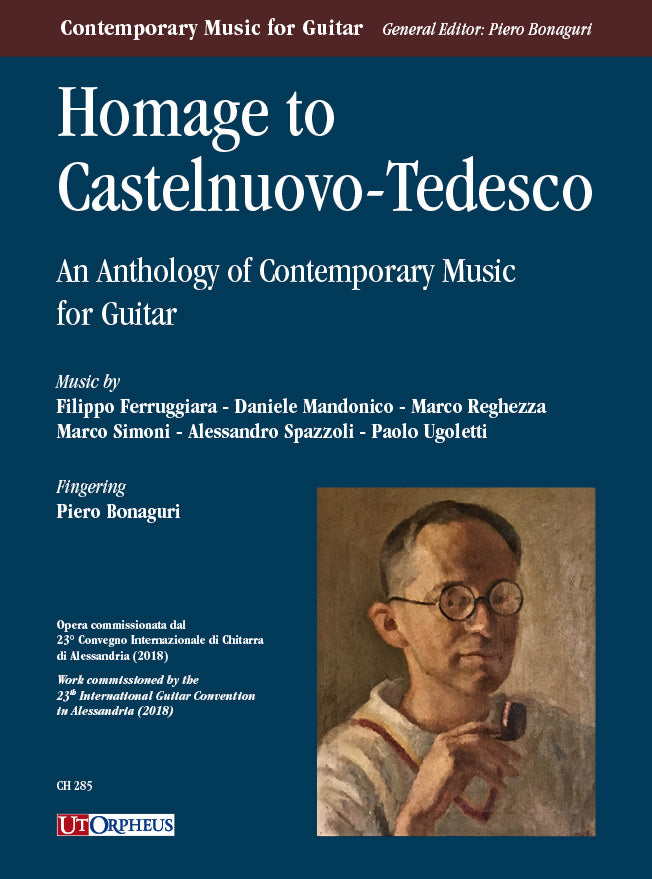Homage to Castelnuovo-Tedesco
In stock and typically ships within 1 business day.
- Composers: Filippo Ferruggiara (1990-), Daniele Mandonico, Marco Reghezza (1968-), Marco Simoni, Alessandro Spazzoli (1964-), Paolo Ugoletti (1956-)
- Fingering: Piero Bonaguri (1687-1750)
- Instrumentation: Guitar
- ISMN:
- Size: 9.1 x 12.2 inches
- Pages: 24
Description
I am particularly happy about the publication of this volume, the project of which has been supported by the International Guitar Convention in Alessandria, marking the fiftieth anniversary of the death of the great Italian composer Mario Castelnuovo-Tedesco. This is a musician to whom all guitarists owe a great deal (and not just guitarists) since he wrote some of the most beautiful and widely performed music of our repertoire.
The pieces collected together in this volume share the freedom and artistic sincerity shown by Castelnuovo- Tedesco ("insobornable servidor de la verdad artistica", as he was described by Andrés Segovia), showing, furthermore, that it is still possible nowadays to have a living and continuing relationship with European musical tradition, without the necessity for a programmatic severance.
In particular, I would like to point out in this respect how some of these pieces have been written by very young composers, Filippo Ferruggiara and Daniele Mandonico, who have been working on this project together with their teacher, Paolo Ugoletti, from the Conservatory in Brescia. Another characteristic common to these pieces is that of nearly always going back to forms and procedures dear to Castelnuovo- Tedesco and sometimes taking an idea from one of his melodies. Thus, Marco Reghezza, born in 1968, agreed to complete the rough draft of one of the Appunti (the final unfinished work of Castelnuovo-Tedesco), called "Il Malinconico". Daniele Mandonico's piece on elevenths also refers to the Appunti, written as though to continue the original series of "Appunti" on intervals which went as far as tenths. The same applies to the chromatic "Appunto" by Filippo Ferruggiara which, in the other piece of his in the collection, "Ricordi", could refer to Castelnuovo-Tedesco's American period. Marco Reghezza, in his Sonatina, and Alessandro Spazzoli are inspired by several themes included in the collection of piano pieces Evangélion, while Paolo Ugoletti agreed to write a ‘greeting card' on the name of this Composer, using the same procedure as that adopted many times by Castelnuovo-Tedesco. Marco Simoni, the only Tuscan composer in this group, goes back to a Gregorian Eastertide theme which may refer to the love of Medieval music and culture often shown by Castelnuovo-Tedesco. An example of this is the Passacaglia sul tema del "Dies Irae" and the Cantico per una statuetta di S. Bernardino di Niccolò dell'Arca.
My thanks go to the composers who joined the project and to Diana Castelnuovo-Tedesco for her valuable collaboration. (Piero Bonaguri)
Works:
- Ferruggiara: Ricordi
- Ferruggiara: Studio
- Mandonico: La Rondine
- Reghezza: Il Malinconico
- Reghezza: Sonatina
- Simoni: Sicut Dies Illuminabitur
- Spazzoli: Ouverture
- Ugoletti: Greeting Card sul nome di Maria Castelnuovo-Tedesco
Publishers use a lot of words to describe what they sell, and we know it can be confusing. We've tried to be as clear as possible to make sure you get exactly what you are looking for. Below are descriptions of the terms that we use to describe the various formats that music often comes in.
Choral Score
A score for vocalists that only contains the vocal lines. The instrumental parts are not there for reference. Generally, cheaper than a vocal score and requires multiple copies for purchase.
Facsimile
Reproductions of the original hand-written scores from the composer.
Full Score
For ensemble music, this indicates that the edition contains all parts on a single system (there are not separate parts for each player). In larger ensembles, this is for the conductor.
Hardcover
Hardbound. Generally either linen-covered or half-leather.
Orchestral Parts
Similar to a wind set, this is a collection of parts. In the case of strings, the numbers listed are the number of copies included, though generally these are available individually (often with minimum quantities required).
Paperback
When publishers offer multiple bindings (e.g. hardcover) or study scores, this is the "standard" version. If you're planning to play the music, this is probably what you want.
Performance / Playing Score
A score of the music containing all parts on one system, intended for players to share. There are not separate parts for each player.
Set of Parts
For ensemble music, this indicates that there are separate individual parts for each player.
Solo Part with Piano Reduction
For solo pieces with orchestra, this is a version that contains a piano reduction of the orchestra parts. For piano pieces, two copies are typically needed for performance.
Study Score
A small (think choral size) copy of the complete score meant for studying, and not playing. They make great add-ons when learning concertos and small chamber works.
Vocal Score
A score prepared for vocalists that includes the piano/organ part or a reduction of the instrumental parts.
Wind Set
For orchestral music, this is a collection of wind and percussion parts. The specific quantities of each instrument are notated.
With Audio
In addition to the printed music, the edition contains recordings of the pieces. This may be an included CD, or access to files on the internet.
With / Without Fingering (Markings)
Some publishers prepare two copies - a pure Urtext edition that includes no fingering (or bowing) suggestions and a lightly edited version that includes a minimal number of editorial markings.


